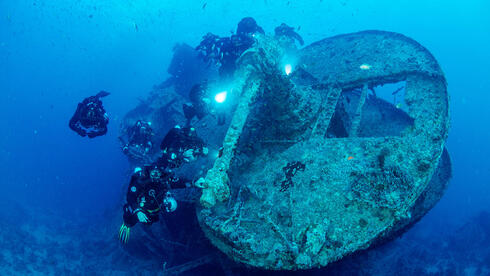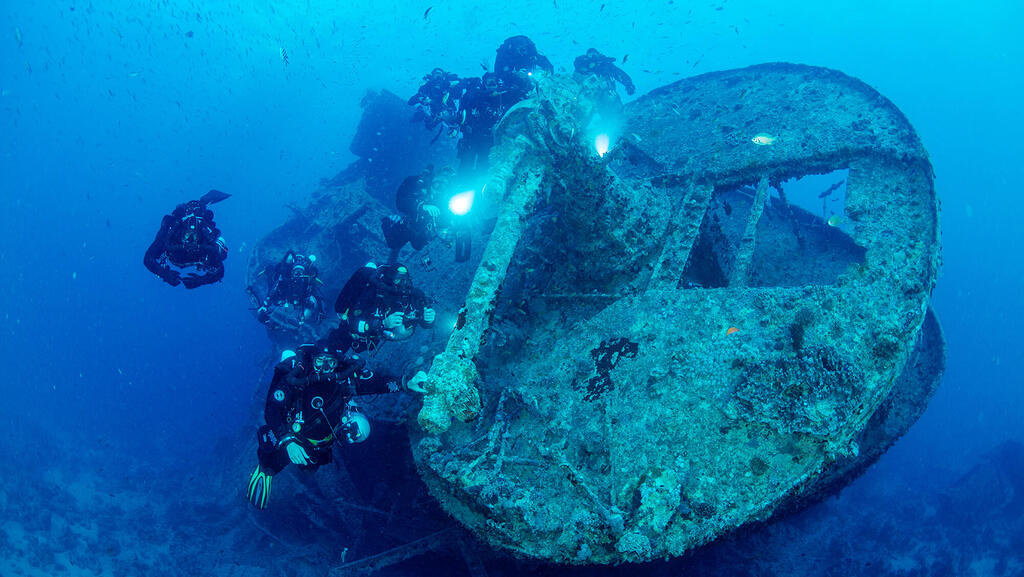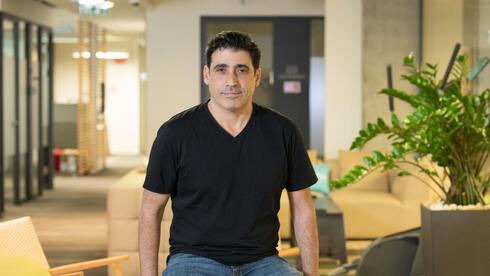
Garbage time: A ticking bomb in the middle of the sea
Pollution does not always float on the surface of the water: the bottom of the oceans has become a dump of ammunition and dangerous weapons, from shells to leaking chemical bombs and radioactive materials. Meanwhile, nature is trying to find its own balance, and new research reveals that on the vast plastic islands in the ocean, communities of previously unknown tiny creatures are thriving.
South of Japan, at the bottom of the Pacific Ocean, there is an abyss so deep that you could bury Everest in it and still be left with two kilometers of depth. This is the Challenger Deep - the deepest point known to man, which is 10,984 meters below sea level. The Challenger Deep is part of the Mariana Trench, an oceanic depression formed at the boundary between two ancient tectonic plates, where unique geological processes occur, such as huge underwater mud volcanoes, one of which emits liquid carbon dioxide, and a black sulfur pool, which has been observed only one other place in the solar system — Io, one of Jupiter's moons.
In the hollow, there is one of the rarest growth environments in the world, where living creatures exist side by side through photosynthesis and chemosynthesis - energy that is produced from chemicals and is required in places where sunlight does not penetrate. The area is so unique that in 2009 the United States declared its territory a National Maritime Monument, and in 2017 UNESCO declared it a World Heritage Site. In 2019, one plastic bag was found at the bottom.
1 View gallery


Cannon on a British ship sunk in 1941 off the Sinai coast
(Photo: Franco Banfi / Biosphoto via AFP)
Victor Vescovo, the diver who found the bag, was the third person to ever reach the bottom. Before him were the oceanographers Dan Walsh and Jacques Piccard in 1960, and the director James Cameron in 2012. Vescovo dived deeper than his predecessors, to a depth of almost 11km, as part of a multinational attempt to explore the deepest points in the five oceans. On his way down, he saw pink snail fish, an achiora worm, and several new species of crustaceans. At the very bottom, he also found candy wrappers.
The presence of the garbage at the site received very few headlines, and the media focused mainly on the fact that Vescovo surpassed his predecessors and dove 16 meters deeper than Walsh and Picard. The fact that the amphipods had high pollution levels of a toxic and prohibited chemical (PCB), as if they lived in the most polluted rivers in the world, did not attract special attention. Two conclusions were inescapable at that moment: no habitat on Earth, no matter how isolated, escaped the influence of the human race; and humanity is indifferent to its destructive and unceasing influence.
"Ignored a known danger"
The systematic and extensive pollution of the oceans did not begin with the direct discharge of sewage or plastic but under the auspices of wars, when the sea itself became a battlefield. A step up occurred in the First World War, when countries began to deliberately throw into the sea or on land conventional and chemical munitions that they no longer wanted, whether they were broken, unusable, or forbidden to use due to loss. Deeper was better, but not as a binding principle.
After World War II, the phenomenon intensified and every possible munition was thrown into the sea - naval mines, aerial bombs, grenades and torpedo heads, alongside tanks filled with toxic materials such as bombs and mustard gas shells, hydrogen cyanide, arsenic trichloride and diphenylchloroarsine (known as Clark 1 and Clark 2), white phosphorus bombs, cyanogen chloride, sarin compounds, Lewisite and phosgene bombs. The burial sites spanned all the seas and oceans, from the Great Barrier Reef in Australia, through Nova Scotia and Hawaii to the Mediterranean Sea.
Dumping munitions at sea as an accepted practice continued until at least 1975, when the London Conference put an official end to the practice. The change accelerated after fishermen pulled out mustard bombs and nerve gas canisters from the sea and suffered severe burns and sometimes death. The conference did not refer to weapons that had already been discarded. "The perception at the time was that the environmental significance of throwing the munitions into the sea was minor," marine biologist Prof. Jacek Bełdowski of the Polish Academy of Sciences explains to Calcalist.
Bełdowski manages projects and research on the subject in NATO and the European Union, and his Polish origin is relevant to the story. In environmental terms, the Baltic Sea, which is partly in the territory of Poland, is the biggest victim of the demobilization of Nazi Germany. Along with an unknown amount of conventional warfare materials, the fact that 90 million people live around the Baltic Sea, which is relatively shallow and that the water regeneration in it is poor, has contributed to the fact that there have been hundreds of life-threatening interactions between people and the weapons thrown into it.
These mutual actions continue to take place, with the most famous of them taking place in September 2022 - when explosive charges hit the two Nord Stream underwater gas pipelines in the Baltic Sea, as part of the war between Russia and Ukraine. The explosive device hit a World War I-era chemical weapon that had been buried near the pipelines, and this poisoned the water in the Bornholm Basin with mustard gas. Toxic gas levels were recorded in the area for 34 days. The danger was already known when the pipes were laid. "When we built Nord Stream, they discovered the stockpiles of chemical munitions," notes Bełdowski, "and added 200km of pipelines just to bypass the problem and not address it."
The weapons that reside at the bottom of the oceans are not only chemical. In a report written in 1993 by a committee established by then-Russian President Boris Yeltsin, three decades of dumping nuclear munitions into the waters near the Novaya Zemlya group of islands were documented. A 2019 study estimates that approximately 17,000 radioactive objects are scattered over thousands of square kilometers of sea, Including an entire nuclear submarine and 18 nuclear reactors. The scattering is so secretive and random that a diver searching for sea cucumbers in the Pacific Ocean in 2016 encountered part of a nuclear bomb carried by an American bomber, which was hit in an exercise in the area 66 years earlier.
The Organization for the Prevention of the Proliferation of Chemical Weapons emphasized in a special report that the danger from buried munitions is immediate: terrorist organizations plant weapons buried at a relatively shallow depth of up to 30 meters; fishermen accidentally remove the munitions, are injured and killed from exposure to it (the last of them was killed in January of last year); ammunition is washed ashore and collected by locals; and the increasing development of marine infrastructures related to agriculture, wind farms, cables and oil or gas pipelines leads to many encounters with dangerous substances.
Among other things, the OPCW mentions the "amber problem" that exists mainly on the coast of Germany, where white phosphorus that was thrown into seawater washes ashore and is curiously collected due to its amber appearance. These amber-like lumps burn automatically when they dry, and reach a temperature of up to 1,300 degrees Celsius, which endangers those who hold them. Meanwhile, there is no protocol or procedure that dictates how to act to detect munitions in the depths, and how to map the seabed or mine it safely.
"Time is running out"
The prolonged stay in the depths of the sea has an effect on the ammunition, and it wears out. Time corrodes the metals, bombs and containers, and the toxic and carcinogenic substances contained in them are in danger of leaking which could harm the organisms living in the water. "The conditions at the bottom of the sea are very heterogeneous, there will never be the same corrosion rate in all ammunition," Bełdowski explains. "Everything depends on the environmental conditions and technical things from the time of production. So it is very difficult to predict whether the corrosion will lead to the release of harmful substances. In most cases, it leads, at least partially, to toxic compounds."
Bełdowski and other researchers are constantly trying to produce models and methods that will predict the state of the landfills and the danger of corrosion and leakage seen from them, in order to produce a decision support system that will help determine which ammunition stockpiles must be dealt with urgently, and which of them are better left untouched, because handling them will accelerate dangerous processes. In March, the first monitoring project for the hundred-year-old problem began, led by the Polish Academy of Sciences and the marine biologist.
Meanwhile, countries and organizations are slow to react to the danger. It was only in 2013 that the United Nations passed the first resolution according to which the weapons thrown into the sea are dangerous to the environment, and this was approved in 2019. The European Union made a similar announcement in 2020. From the research conducted by Bełdowski it becomes clear that corrosion of artillery shells will lead to breaches and leaks in the year 2100, and to leaks in ammunition tanks Between 2020 and 2030. "So now," he emphasizes, "time is running out."
And yet, it is not clear what is the right way to dispose of all the ammunition. A study conducted in Germany in 2016 on the disposal of conventional ammunition found that its explosion at sea could lead to extensive damage. Although there are some private companies that offer "bomb hunting at sea" services, it has been found that this method creates wind waves that harm animals. An attempt to prevent these shock waves with lower-intensity explosions led to the dispersion of a toxic TNT compound over long distances across the sea or ocean floor.
Germany, which is at the forefront of the fight against the problem, is the only country in the world that has allocated a grant for the production of a facility for the safe disposal of naval ammunition. The 100 million euros it allocated last year are intended for the construction of a kind of robotic barge, which will retrieve the ammunition from the bottom and burn it on a floating surface in an environmentally safe way. Regarding the chemical weapons, Bełdowski says that this causes legal complications. "After the country pulls out the chemical munitions, it has to declare itself a chemical weapons state, then declare that it wants to destroy its chemical arsenal, and then the OPCW has to assign an inspector to oversee the destruction. It’s complicated."
There is also no agreed answer to the question of which ammunition should be dealt with first. "One type of chemical ammunition that causes concern is arsenic-based materials, such as Clark 1 and 2," Bełdowski explains. "Studies have found that in fish, some of the metabolites of those substances that are based on arsenic are a million times more toxic than the parent compound. This means that when the fish tries to metabolize the accumulated toxin, it actually produces a stronger toxin. But the treatment of conventional ammunition is more urgent, if only because of the large amounts of it and the potential for carcinogenic concentrations in it."
Dwarf jellyfish and blue dragon
Far from the munitions buried in the depths of the sea, on top of the waves themselves, is the Great Pacific Garbage Patch (GPGP) - a cluster of marine garbage carried on top of ocean currents and extending over 1.6 million kilometers, an area twice the size of the state of Texas. The estimates regarding the extent of plastic in the place vary, and some of them suggest that it consists of 1.8 trillion pieces of plastic, with a total weight of 100,000 tons. As in the case of the ammunition, there is no unequivocal answer to the question of whether it would be right to remove it from there.
The GPGP was first identified in 1997 by oceanographer Charles Moore, who came across it by chance. This is not the only plastic island, but it has become a symbol of all that is plastic pollution. The patch is huge but far from the eye and the heart (and also from the territorial waters of each country), the plastic island moves without interruption. Cleaning up the island will be a project of enormous proportions - the National Oceanic and Atmospheric Administration's (NOAA) Marine Debris Program estimated that 67 ships that would labor to clean up the plastic for an entire year would handle less than 1% of the waste in the GPGP.
Until the countries of the world decide to cooperate, the UN drafts statements. In 2022, a preliminary version of the "Plastic Convention" was drawn up, which is the first global agreement to deal with the plastic problem in the sea. But like the UN resolutions on ammunition, the Plastic Convention also does not impose sanctions and states only that the member states of the organization will work to reduce the use of polluting plastic. Meanwhile, those working to reduce plastic waste are mostly non-profit initiatives.
One of them, called TOC (The Ocean Cleanup), launched in August a method that collected 46 tons of plastic in one cleanup operation. The method developed by the project involves using two ships to cast a 2.2km long net into the sea, dragging it a distance in the water, and bringing it aboard when it is full - until its contents spill out of it like an old sock. The loot is diverse and includes boxes, containers, ropes, nets, and pieces of colorful and broken plastic. A spectacle as startling as it is embarrassing, evidence of the depth of humanity's failure as a species that seeks to thrive. After the cleanup operation, the project announced that it intends to treat the waste area of the Pacific Ocean.
While many celebrated the TOC announcement, some scientists dared to ask: Maybe it's better not to clean up GPGP? "This is not an island of garbage, it's an ecosystem polluted by plastic," marine biologist Dr. Rebecca Helm, who studied life on the plastic island, told Calcalist. "The amount of plastic on the island is definitely noticeable, but the amount of life is amazing." In a study from May last year led by the University of Hull in England, in which she was a partner, the researchers stated: "The more plastic we found, the more life we found."
"These animals, called Neuston, are subject to the same forces of wind, currents, and waves that plastic is subject to," Helm explains. On the surface of the open water, among the pieces of plastic, the research in which Helm was involved found an extraordinary biological diversity, such as a blue sea button, a jellyfish that is up to three centimeters in diameter and looks like a blue disc surrounded by light blue tentacles,
By-the-Wind Sailor, a kind of oval mollusk with a small, hard sail that carries it on the surface of the sea, and the blue dragon, a sea snail that cannot swim and moves with the help of the wind and currents.
Although plastic is relatively new, the presence of these species is not. "These specific species are supposed to be right there," Helm says. "They probably lived in this area of the ocean for thousands of years before it became a garbage patch." And so, the good intentions of TOC can be devastating to the biodiversity and ecology of the open ocean. In addition, the use of nets indicates how little is known to science about the richness of life in plastic. "In the study of plastic in the sea, it is quite common to use a net to collect the plastic, take it out of the net, and throw the rest aside. All the life that is collected is simply thrown out the window," says Helm.
The TOC is aware of this, and ordered an environmental impact report of the nets they plan to cast. But even the report, Helm notes, does not help assess the impact of the cleaning process on the living creatures in the water. "Most of the animals will simply be torn from the net," she explains and adds that studies have found that most of the living creatures that survive the operation will die within a day of being returned to the water. The mortality rate of these creatures is very high even if each one is gently removed from the nets and returned to the water.
"When I started researching the issue I thought, yes, this is a top priority, I felt it was a moral imperative. It's disgusting that all this plastic was in the middle of the open ocean, so far from the coast. How could humans do such a thing? And yes, I was very supportive of cleaning up the plastic, Especially with methods that are gentle on the environment, not necessarily like TOC, where each of its ships burns approximately one million liters of fuel per trip, and drags a huge net that is dangerous to marine life," says Helm. "In November, I went to the third UN negotiations on the Plastics Convention in Kenya and started to change my mind."
What did you learn?
"The first thing is the huge amount of fishing gear that is intentionally thrown into the sea every year. More than 70% of the plastic in the GPGP comes from fishing gear, and these trends are only getting worse. We need to stop plastic at the source and find ways to put pressure on these industries to collect plastic, to stop throwing away their nets when they're done with them. The second thing was when a representative from Bangladesh told me that a river runs through the center of their capital, and the river bed has risen three meters because of all the plastic at the bottom of it.
"I mean there are places in the world where the natural systems are very polluted, the rivers are clogged and ponds are formed with an abundance of malaria. You can see how plastic pollution is putting people at risk right now. When I think about the amount of money, time, and human effort invested to reach the middle of the open ocean and collect plastic I feel a little guilty. I was so focused on this symbolic, mythological thing, the great garbage patch of the Pacific Ocean, that I missed the environmental catastrophes happening around us."
Meanwhile, more studies are being done on the plastic stain. One of them, recently completed by the Smithsonian Environmental Research Center in the US, found that the plastic island has three times more life on it than other floating bodies in the sea. Some of the species, it was discovered, are not inhabitants of the open sea at all but animals and organisms that are supposed to live on the shore, and found themselves clinging to the drifting plastic to create new communities. The migration of life from the beach to the sea is not a new phenomenon and often occurs on top of algae, wood, and floating rocks. Communities living in the ocean. So, in its own way, nature wins again.














